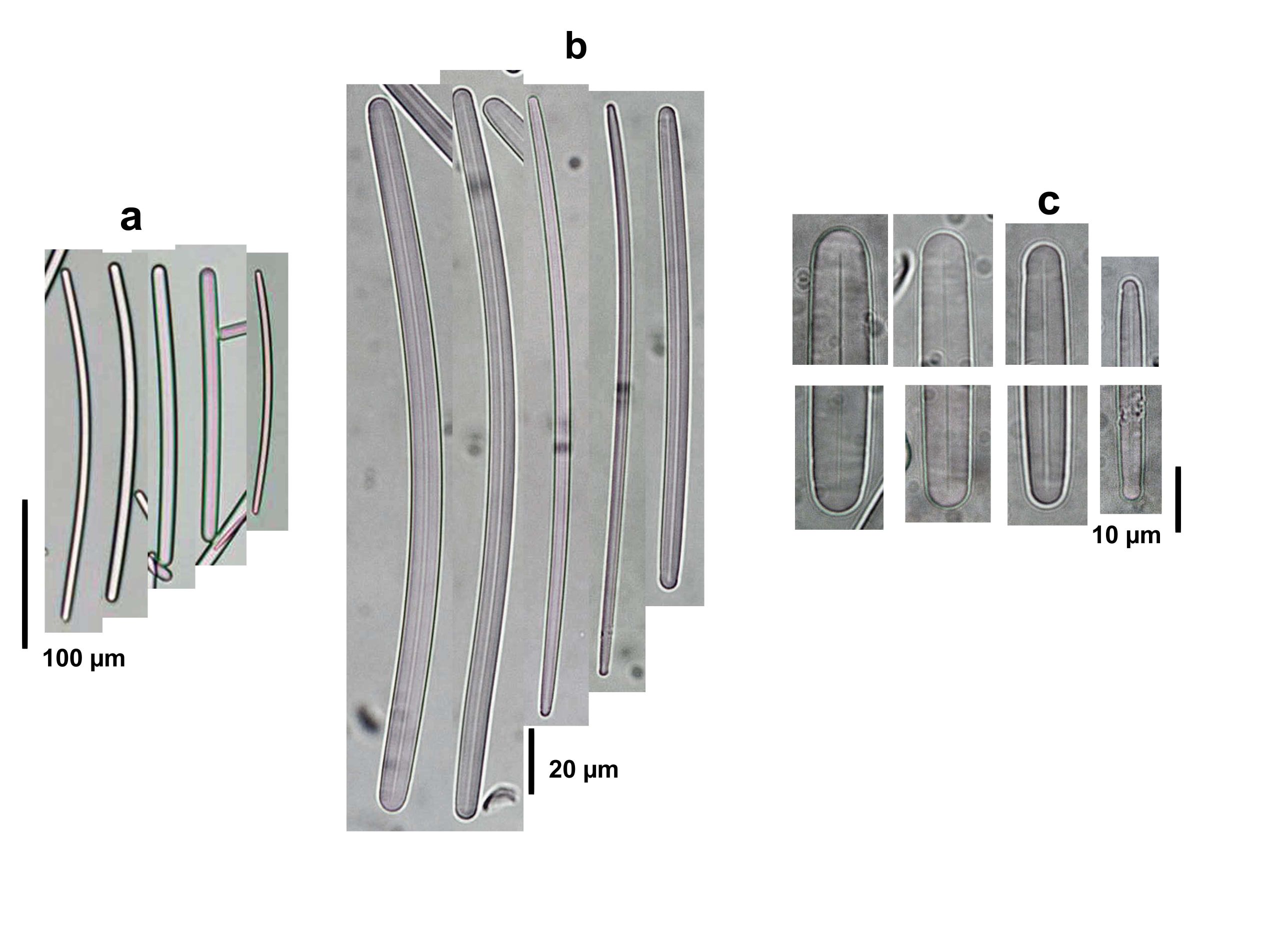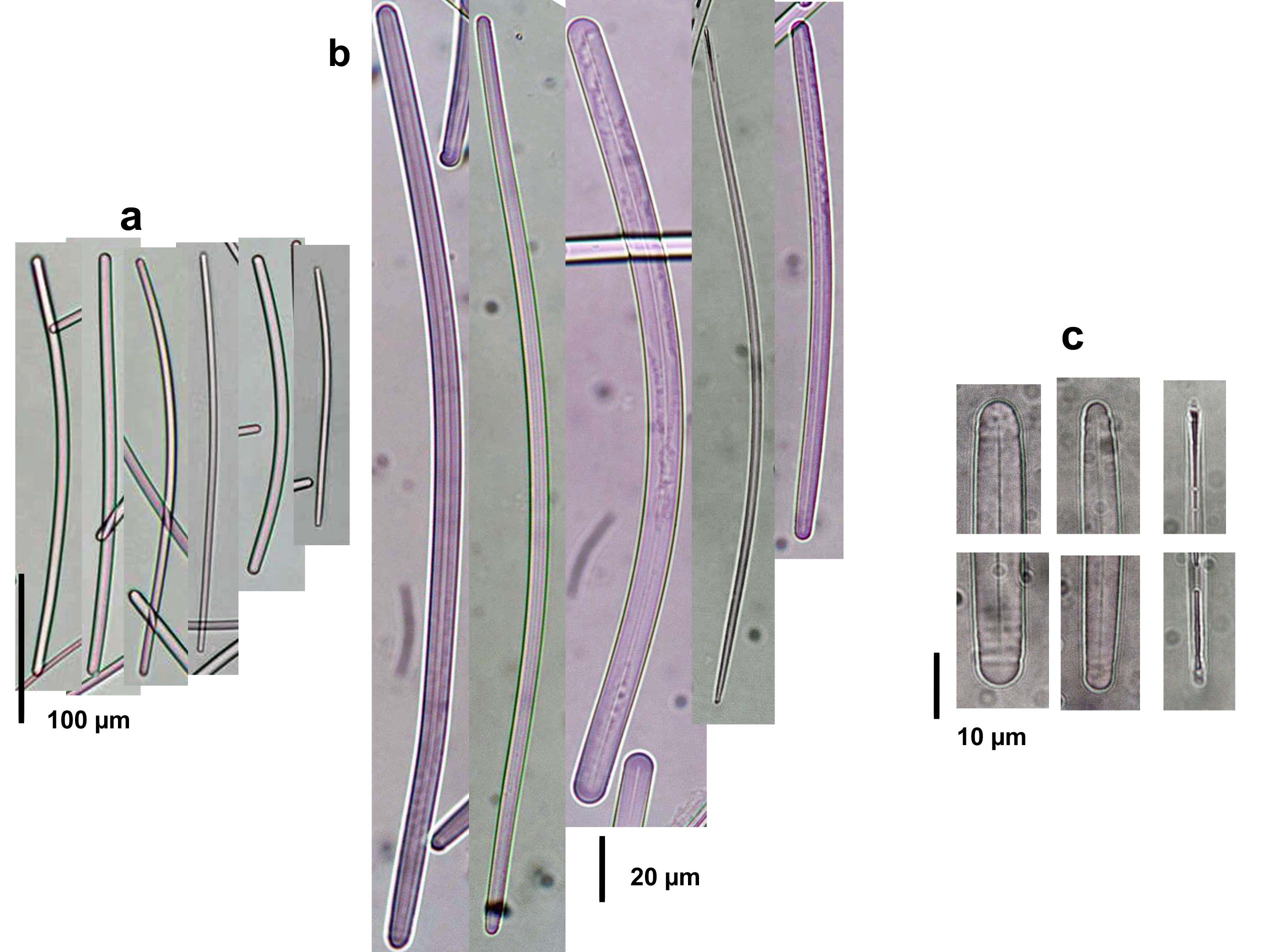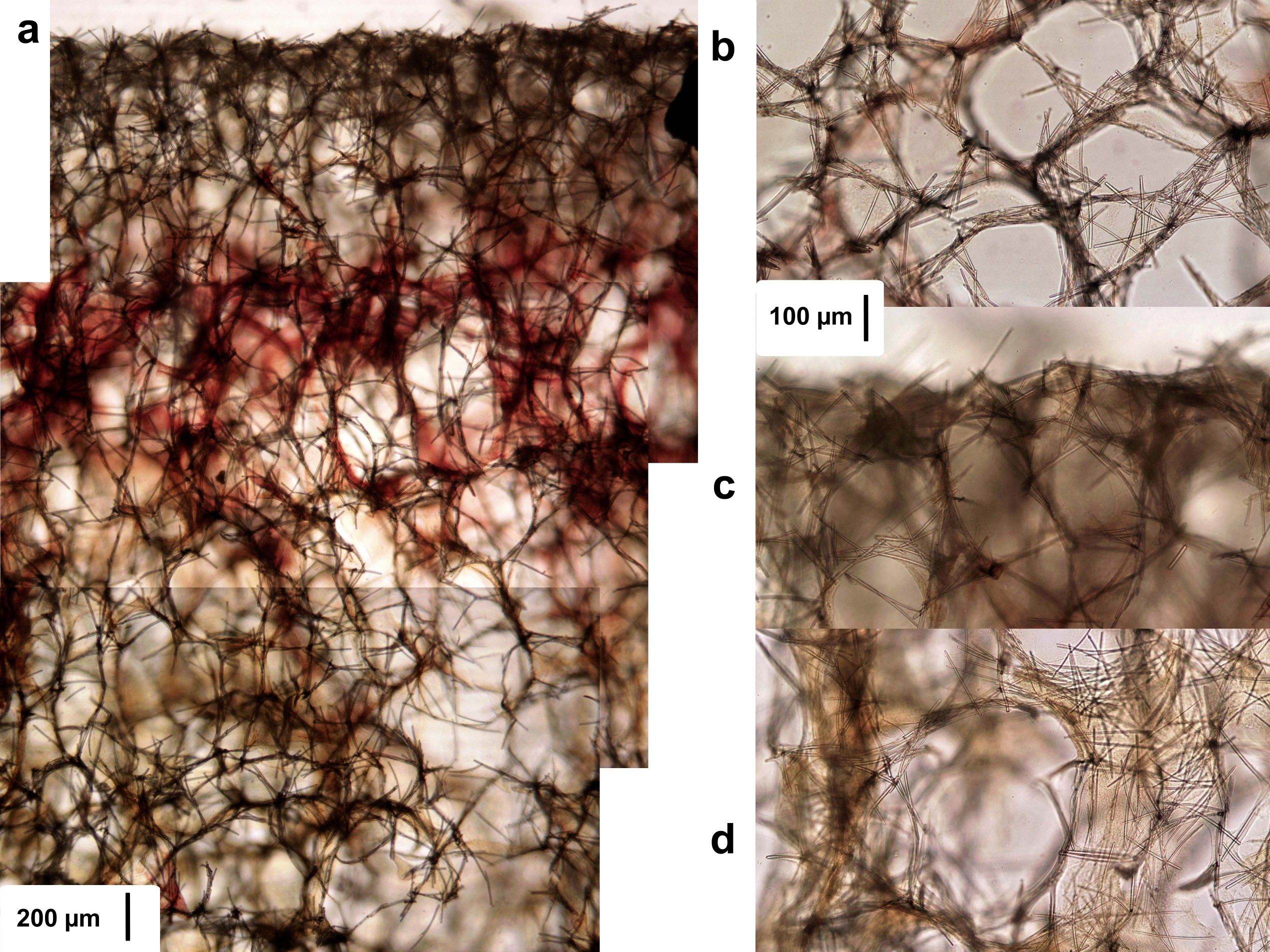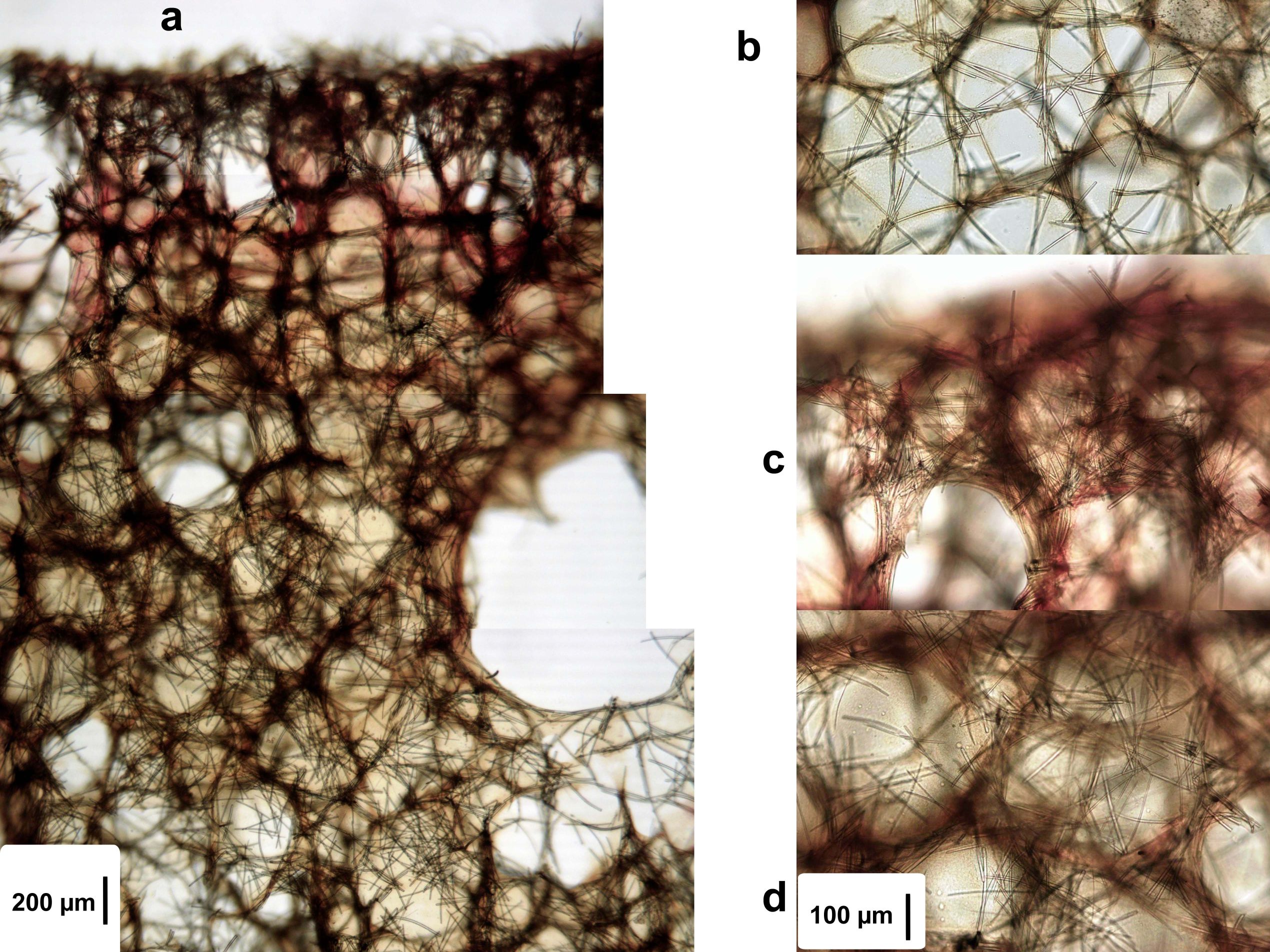the Sponge Guide - www.spongeguide.org
Observed Characteristics:
pink-lilac
cinnamon-tan
fan
lobate
tube
vase
crumbly
soft
tough
Bahamas
Colombia
Species Description and Notes
Description: Fully grown individuals are clusters of thick tubes, almost vases, reaching 50 cm in diameter and height, each tube being 5-15 cm in diameter and with 2-5 cm thick walls and 2-10 cm oscules-peudoscules. Tubes arise from a relatively narrow common base and then open and branch out. Younger individuals can be lobed with apical or lateral oscules. Surface is even, smooth or slightly rugose, sometimes with grooved lines of zoanthids. Concentric lines of oscules are seen inside the tubes. Consistency of large specimens is softly compressible, crumbly, being tougher in some individuals. External color is cinnamon-tan with rosy or brownish hues; subsurface color purplish, interior cream. Skeleton as ascending paucispicular (1-3 spicules across) tracts variably bound by spongin, up to about 60 µm thick, separated some 125-250 µm, irregularly interconnected by single spicules or spicule tracts, forming a slightly rounded to polygonal reticulation of 100-400 µm mesh diameter. Growth bands can be discerned near the surface. There is a slightly paratangential and incomplete ectosomal reticulation of single spicules or of paucispicular tracts that overlies the subsurface reticulation. Deeper in the choanosome there are many spicules strewn in confusion in between spaces of the main reticulation. Tougher specimens were found to have a much thicker reticulation, 3-8 spicules wide, and with more spongin. Spicules are strongyles, slightly curved, in an ample variety of sizes, 110-280 µm long and 2.3-10 µm, with some variation among individuals in the same site; endings are from rounded, to slightly rugose to mammiform, being slightly asymmetric, one end slightly narrower than the other; developmental (thinner) stages tend to have narrower ends, towards oxeote.
Notes: This is a deep reef species, living exposed. There are three distinct morphotypes (herein named "branching", "castle" and "tubular") of slightly toughly compressive to crumbling, yellow to tan sponges, that share a skeleton of slightly asymmetric strongyles arranged in ascending and interconnecting fiber tracts. We have tentatively called them Amphimedon? following the Systema Porifera (Hooper & van Soest, 2002) and in particular for the similarity in skeletal arrangement to A. viridis Duchassaing & Michelotti, 1864, also pictured here. For further discussion see notes on the "branching morphotype". From its shape and color, this "tubular morphotype" can be confused in the field with Agelas tubulata Lehnert & van Soest, 1996, also pictured here, but they are readily distinguished by the very tough consistency of the latter. It appears to be also similar to Xestospongia (possibly Neopetrosia) caminata Pulitzler-Finali, 1986, but the latter is stiffer and brittle, its color is purplish brown and has oxeas as spicules.
Tissue and Spicule Images

Spicule Images: a), b) Strongyles at two different magnifications, with thinner, developmental stages tending to be oxeote; c) endings of spicules. Sample from the Bahamas.
Source Specimen: http://www.spongeguide.org/ thumbs/00013/00435.JPG

Spicule Images: a), b) Strongyles at two different magnifications, with thinner, developmental stages tending to be oxeote; c) endings of spicules. Sample from the Bahamas.
Source Specimen: http://www.spongeguide.org/ thumbs/00039/01198.jpg

Tissue Images: a) Perpendicular section at the surface; b) tangential view of the surface; c) perpendicular section at the surface; d) view of the deeper choanosome. Sample from the Bahamas.
Source Specimen: http://www.spongeguide.org/ thumbs/00013/00435.JPG

Tissue Images: a) Perpendicular section at the surface; b) tangential view of the surface; c) perpendicular section at the surface; d) view of the deeper choanosome. Sample from the Bahamas.
Source Specimen: http://www.spongeguide.org/ thumbs/00039/01198.jpg
Images
Amphimedon? sp.-"tubular morphotype"
Location: Bahamas, Plana Cays
Photographer: Sven Zea
Location: Bahamas, Plana Cays
Photographer: Sven Zea
Location: Bahamas, Plana Cays
Photographer: Joseph Pawlik
Location: Bahamas, Plana Cays
Photographer: Joseph Pawlik
![<i>Amphimedon? </i> sp.-"tubular morphotype" <br />[Bahamas, Little San Salvador]](thumbs/00035/01166.jpg)
Location: Bahamas, Little San Salvador
Photographer: Sven Zea
![<i>Amphimedon? </i> sp.-"tubular morphotype" <br />[Bahamas, Plana Cays]](thumbs/00039/01198.jpg)
Location: Bahamas, Plana Cays
Photographer: Sven Zea
![<i>Amphimedon? </i> sp.-"tubular morphotype" <br />[Bahamas, Plana Cays]](thumbs/00039/01199.jpg)
Location: Bahamas, Plana Cays
Photographer: Sven Zea
![<i>Amphimedon? </i> sp.-"tubular morphotype" <br />[Colombia, San Andrés Archipelago, Serrana Bank (atoll)]](thumbs/00115/01941.jpg)
Location: Colombia, San Andrés Archipelago, Serrana Bank (atoll)
Photographer: Sven Zea